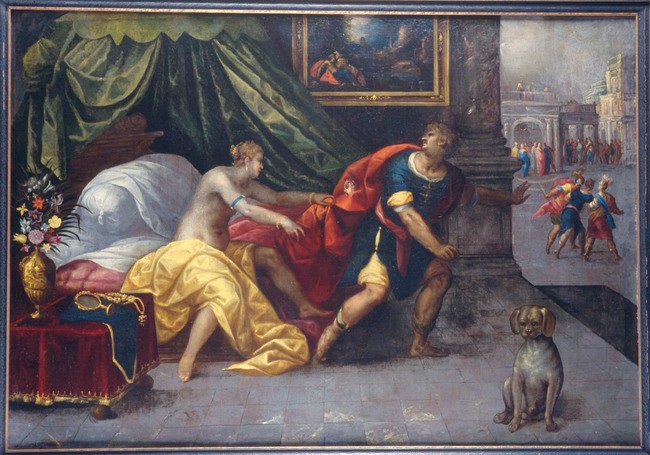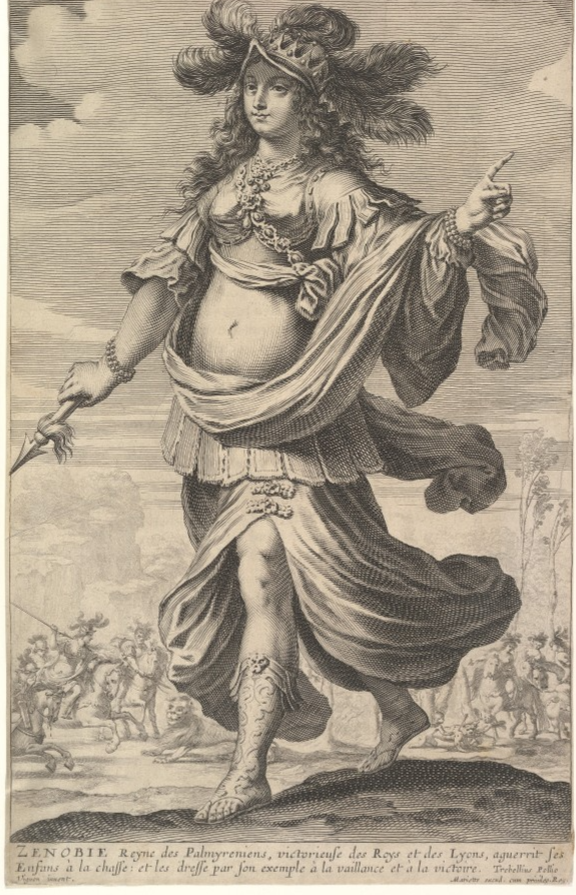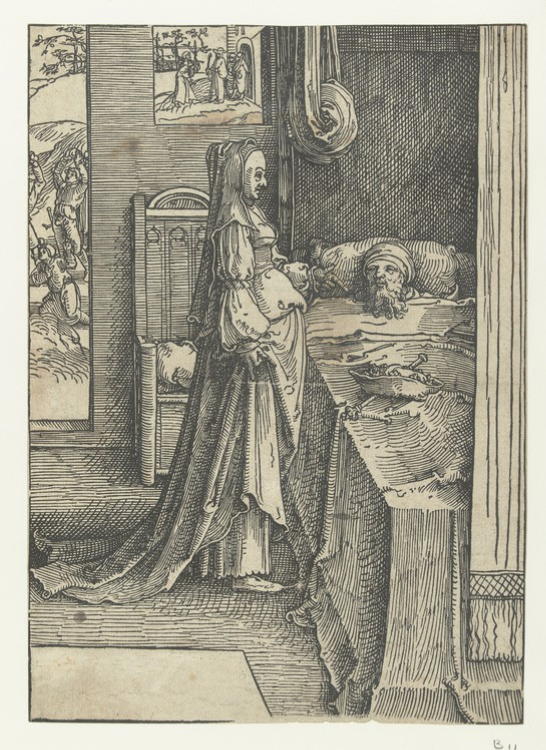Dinah Wouters
The scene is a familiar one in art history: a harassed Joseph runs away from the naked woman who reaches after him and is just able to get hold of his cloak. Later in the story, which is recounted in the Bible book of Genesis, she will use the cloak as evidence while declaring to her husband that Joseph tried to rape her.

Her name became a synonym for the often-used literary motif of the woman who falsely accuses an innocent man of (attempted) rape. Or rather: her husband’s name, because the woman herself is not named in the Bible. Instead, as so many women in literary history, she became known by the name of her husband, as ‘Potiphar’s wife’.
The story did not just become the prototype for the literary motif but was also retold time and again in its own right, mostly as a part of the larger narrative of Joseph’s life, from the betrayal by his brothers, his time as a slave in Potiphar’s household, to the long years spent in prison after being wrongly accused, ending on the day that he explains Pharaoh’s prophetic dreams and is promoted to vizier of Egypt.
On the early modern stage, the story of Joseph was a favourite from the beginning, thanks to its epic qualities, gripping emotional turns, and morals. More than a hundred different dramas about the subject from the sixteenth and seventeenth century are extant. But how did these texts deal with the fact that one of the protagonists is not named in the source text?
If you start looking at character lists, what strikes you is the great variety in the names that Potiphar’s wife receives. In a preliminary survey of 60 dramas in Latin, German, Dutch, French, Italian, Spanish, and English, I found that 22 do not treat the episode with Potiphar’s wife, but the other 48 yield no less than 21 different names for the same character. Once a nameless woman in the Bible, on the stages of early modern Europe Potiphar’s wife becomes a woman known by many names.
In the TransLatin project, we are working on a database that will gather the texts and metadata of Neo-Latin dramas. Character lists will be part of these data and a good tool for research on a larger scale than the individual dramatic text. I will use the example of Potiphar’s wife to show how the comparison of character names might reveal the traces of networks of influence that connected literati and playwrights across Europe and open up further research.
The Wife
A first group of texts remains loyal to the biblical text and does not give Joseph’s accuser a name at all. This is the case in the fifteenth-century mystery plays such as the Mistère du vieil testament and Les mystères de la Procession de Lille, where she is called ‘la Dame’, and in the Italian Rappresentatione di Giuseppe figiuolo di Giacobbe, where she is ‘la Donna’. In a German Fastnachtspiel from 1608, a genre that likes to work with ‘types’ of characters, she is ‘Potiphars Weib’. Later in the seventeenth century, the famous Jesuit playwright Jacob Bidermann prefers to call her ‘hera’ or ‘mistress’ in Latin, and in a Spanish drama by the Mexican poet Sor Juana Inés de la Cruz she is still ‘la Mujer’.
It is difficult to say whether the choice not to name the female character by these later authors, who are not otherwise very loyal to the biblical story, is an unmarked choice or a choice that marks a difference with other texts. The absence of a name is most striking, however, with two German humanists, Hans von Rüte and Sixt Birck, because they deviate from a norm among German humanists and protestant school authors of the sixteenth century to adopt the name given by the Dutch Neo-Latin playwright Cornelius Crocus: ‘Sephirach’.
A New Standard
It seems that the name ‘Sephirach’ for Potiphar’s wife was coined by Crocus himself. ‘Sephora’ or ‘Zippora’ is a biblical name, one that is carried both by the wife of Moses and by a Hebrew midwife in the book of Exodus. It is thus associated with Egypt but also with the Hebrews. Crocus’ version of the story, focusing on Joseph and Sephirach, became a smashing success: between 1535, when it was first performed, and 1650 it was reprinted 21 times, first in Antwerp, then Cologne, Paris, Strasbourg, Augsburg, Basel, Amsterdam, and Dortmund.
Its influence can easily be gauged not only from its many reprints but also from the occurrence of the name ‘Sephira’ (in various spellings) in other dramas. It was adopted in the German plays by Thiebolt Gart, Peter Jordan, and Jacob Ruf, which all came out in 1540, five years after the publication of Crocus’ play, by the Latin plays of Andreas Diether (1544) and Cornelius Schonaeus (1592), and in Polish by the dramatist Mikołaj Rej (1545).
By 1600, ‘Sephira’ must have felt like the new standard name for Potiphar’s wife. We find it as well in a Latin play by Theodorus Rhodius (1625) and in two Dutch plays, by Jacob Cats (1620) and Jan Tonnis (1638). The play by Cats was translated into German two times and the translators kept the name of Sephyra, like the translator of Crocus did as well (1583). That seems logical, but it highlights the strange choice made by Hans von Rüte, who translated Crocus’ version and added the translation to his own longer play, but who replaces ‘Sephira with ‘Frow’ (‘Woman’/ ‘Wife’). Then again, von Rüte made his translation in 1538, only three years after the publication of Crocus’ play. It would seem that the name ‘Sephira’ was cemented by the publication of three German dramas in 1540. For Rüte, and for Birck, who also still used ‘Fraw’ in 1539, Crocus’ naming was not yet a norm but an individual choice that they chose not to follow.
Georgius Macropedius, like Crocus a playwright from the Netherlands, also wrote a Latin drama about Joseph that was to be popular among later authors, but it seems that his 1544 play came a decade too late to offer an alternative to ‘Sephira’. Macropedius’ Sephira is called ‘Aegla’. Aglaea, in Greek mythology, is one of the Graces and the goddess of beauty. But there is more: it looks like there might be a reference to the Greek mythological counterpart to Potiphar’s wife, Phaedra. Both Euripides’ and Seneca’s dramas about the queen who falls in love with her stepson and falsely accuses him of rape when he rejects her, acted as a major influence on humanist Joseph dramas. Macropedius did not directly adopt her name, but puts on a wordplay with Greek synonyms: both ‘φαιδρός’ and ‘ἀγλαός’ carry the meaning of ‘bright’ and ‘shining’.
Exotic names from the past
Although Crocus’ act of name-giving was most successful and the only one to be followed widely, his play was not the first one to name Potiphar’s wife. The first European playwright to do so was the Italian humanist Pandolfo Collenuccio in 1523. His humanist drama La vita de Iosep figliuolo di Iacob calls her Beronica. A resemblance to the name of St. Veronica seems not to be at play. Rather, it would seem to refer to a name that was carried by a handful of Macedonian queens of Egypt during the Hellenistic period.
Despite the success of his play, no one followed him in this. However, the logic behind the name – to choose something that carries exotic connotations – did have a following. For example, the German theologian and playwright Aegidius Hunnius went with ‘Misraia’, which means ‘Egyptian woman’ in Hebrew and Aramaic.
The Spanish playwright Miguel de Carvajal chose ‘Zenobia’, the name of the famous queen of Palmyra, who is known, ironically enough, for her chastity. He was followed in this by an anonymous Auto de los desposorios de Joseph from a few decades later, but not by another work that is ostentatiously inspired by his play, the Adversa y prospera fortuna de Joseph. The latter rather chooses ‘Mitilene’, which is the birthplace of Sappho, who was at the time best known for her suicidal passion for a young man named Phaon (she was alleged to have thrown herself off the rocks at Mitilene).

Just as I can only explain Carvajal’s choice of ‘Zenobia’ as a case of exoticism and irony, the name that Martinus Balticus gives to Potiphar’s wife raises some eyebrows as well. ‘Seraphin’, he calls her, which looks like an anagram of ‘Sephira’ but is also very close to Seraphim, the order of angels. The expert on German Joseph dramas Jean Lebeau has tried to explain the choice by suggesting a connection to the Egyptian God Serapis. A name that carries equally positive connotations is Nicodemus Frischlin’s ‘Bithia’. Granted, it is also the mythological name of Scythian women who kill with their one eye, but would probably have been more familiar as the name of the Pharaoh’s daughter who saves and adopts baby Moses. Quite a reversal from Joseph’s seductress!
Slurs
In general, it is remarkable that very few authors choose a name with explicitly negative connotations. A counterexample, however, is Thomas Brunner, who calls Joseph’s accuser ‘Iezabel’, the wicked queen and wife of Achab. Andreas Rochotius calls her ‘Artemon’, after a bossy, role-reversing female character in Plautus, and Balthasarus Voidius makes a connection with Medea, the mythological sorceress who killed her own children.

Joachim Greff, whose German play was published in 1534, a year before that of Crocus, is even more explicit. He gives her the name of ‘Mecha’, which is the Latin word for adulteress and slut. He was followed in this by two plays whose main example seems to lie elsewhere but who do adopt at least the name. First, Bartholomaeus Leschke was mostly following Thiebolt Gart, but it turns out that he preferred the name ‘Moecha’ over Gart’s ‘Sophora’. Second, Josephus Goezius’ play is a loyal imitation of Christian Zyrl (who has ‘Potiphara’), but its character list mentions ‘Potiphara oder Moecha’. Zyrl’s name ‘Potiphara’, in the meantime, attracted not only Adam Puschmann and Goezius, but also Christian Schlayss, even though the latter presents his play as a translation of Hunnius (who had ‘Misraia’). All of these intricate loans take place within the group of German-writing protestants, which goes to show how tight-knitted this sphere of influence was.
Inspiration from Novels and Epics
Sometimes inspiration for the name seems to come from outside theatre. In Nicolas de Montreux’s 1601 Joseph le chaste, the seductress is called Alinde. Only seven years before, the Parisian literary world had been gripped by controversy regarding the first novel of Marie Le Jars de Gournay, the friend and editor of Montaigne. The protagonist of this novel, a Persian princess who is seduced and driven to suicide, carries the name Alinda.
One of the more famous of Potiphar’s wife’s theatrical names, thanks to Joost van den Vondel’s Joseph trilogy, is ‘Iempsar’. It seems that the name is derived from an epic on the story of Joseph by Girolamo Fracastoro, who is most known for his work as an epidemiologist on syphilis. The posthumous publication of this epic in 1555 predated Vondel’s play by 85 years, but attention for it was revived in 1620 through the English translation of the work by Joshua Sylvester, who lived and frequented intellectual circles in the Dutch Republic. Vondel was not the first to use the name ‘Iempsar’ in drama, however. At the end of the sixteenth century, the Polish playwright Simon Simonides had also adopted it from Fracastoro for his Latin Joseph play.
A Spanish play from the late seventeenth century, entitled Los Triunfos de Joseph and (probably falsely) attributed to Calderon, has the name ‘Semsar’, which looks as if it is derived from ‘Iempsar’. Could it be that this name, as if in a game of Chinese whispers, travelled from sixteenth-century Italy to seventeenth-century Dutch literature via an English translation, and ended up at the end of the century in Spain?
Protestant Clusters and Catholic Diversity?
Authors really liked to come up with their own name for a character. Almost a third of the authors that I have looked at prefer to give Potiphar’s wife a name that she never carried before. When you leave out translations, that makes half of these authors. Other examples, which I did not mention, are ‘Gotera’, ‘Nicela’, ‘Demetria’, and ‘Thamna’.
So does that also say something about how much inspiration they take from each other’s plays in general? That is difficult to say at this point in my research, although the fact that mostly protestant authors from German and Dutch-speaking regions band together does seem to indicate so. These are the authors that have been studied most extensively and of whom we know that they were connected and looked at each other for inspiration. Although Crocus was a Catholic, his Latin play influenced two generations of mostly protestant German, Swiss, Dutch, and Polish authors, an influence reflected in their adoption of the name ‘Sephira’. Other smaller clusters among this group are ‘Moecha’ and ‘Potiphera’.
Outside of this group, we mostly find unique names used by authors from other regions (Italy, Spain, France, and England), authors who are mostly Catholic. Is it possible that the Catholic playwrights came to associate the name ‘Sephira’ with Protestant plays and therefore chose their own names, or should we rather read it as a lack of contact? In any case, it seems that the nameless Egyptian woman is a good starting point for exploring the ties between the early modern dramatists who are keen to give her a voice and a name.

